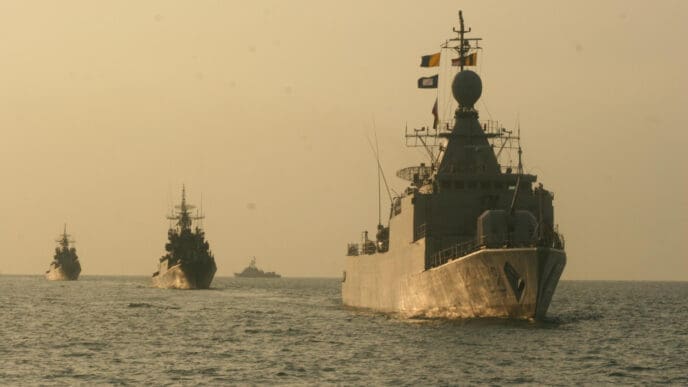One of NATO’s largest annual naval exercises, “Sea Shield 25,” is currently underway in the Black Sea, aiming to enhance cooperation among NATO member countries and prepare for various threats. This exercise takes place amid rising tensions in the region, with the Black Sea holding a strategic position on NATO’s eastern flank. The exercise involves 1,600 Romanian troops and participants from 11 partner nations, including Albania, Bulgaria, Canada, France, Greece, Italy, the United Kingdom, the Netherlands, Spain, the United States, and Turkey.
In total, the exercise features dozens of ships, patrol planes, helicopters, and approximately 2,600 troops from 12 allied countries. These forces are engaged in simulating a range of scenarios, from hybrid threats to maritime and aerial attacks. The complex training operations incorporate live-fire exercises and attack simulations to enhance NATO’s response capabilities.
Approximately 64 kilometers off the Romanian coast, an alarm disrupts the calm sea air as an unidentified target appears on radar, triggering an immediate alert throughout the fleet. Air support prepares for action, and an IAR 330 Puma Naval helicopter takes off on a maritime reconnaissance mission.
Among the units participating is the Mine Countermeasures Black Sea Task Group, established in 2023, which plays a vital role in neutralizing potential underwater hazards. The presence of drifting mines poses a significant challenge to operations, underscoring the need for coordinated efforts and effective communication among NATO forces.
The exercise also includes special forces, combat divers, and experts in chemical, biological, radiological, and nuclear (CBRN) defense, simulating a wide array of modern warfare scenarios. The Commander of Romania’s Navy Fleet, Rear-Admiral Cornel Cojocaru, highlighted the importance of modernization and constant vigilance. Given the ongoing conflict, there have been threats and attacks by the Russian Black Sea fleet on Ukraine, necessitating advanced technology and well-trained personnel.
Since its inception in 2015, “Sea Shield” has provided NATO forces with a platform to refine strategies and bolster collective defense measures in the Black Sea. This year’s exercise concludes on April 11 after twelve days of intensive drills.
The Strategic Importance of “Sea Shield 25”
The exercise “Sea Shield 25” carries significant implications for NATO and its member states, emphasizing the importance of maintaining a robust defensive posture in the Black Sea region. As geopolitical tensions persist, the ability to effectively coordinate and respond to potential threats is crucial for regional stability and security.
For the participating nations, particularly those on NATO’s eastern flank, the exercise serves as a critical opportunity to test and enhance their military readiness. It also reinforces the need for ongoing collaboration and technological advancements to address evolving threats. The presence of advanced equipment and skilled personnel is essential in maintaining a credible deterrent against potential adversaries.
Moreover, the exercise underscores the necessity for NATO to remain vigilant and adaptable in the face of changing security dynamics. By fostering greater cooperation and interoperability among member states, “Sea Shield 25” contributes to the overall resilience of the alliance, ensuring it remains prepared to meet future challenges effectively.














